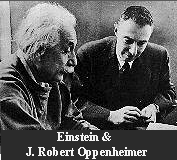
 The premise of nuclear weapons, that the splitting of an atom releases enormous amounts of energy, is based on Albert Einstein's theory of relativity, e=mc2. According to Einstein, in certain situations, mass may be converted to energy.
The premise of nuclear weapons, that the splitting of an atom releases enormous amounts of energy, is based on Albert Einstein's theory of relativity, e=mc2. According to Einstein, in certain situations, mass may be converted to energy.
Einstein's theory was used in 1939 to confirm the discovery of atomic fission. When Otto Hahn & Fritz Strassman bombarded a uranium atom with a single neutron in December 1938, Hahn & Strassman were left with barium, the mass of which is half that of uranium. Because the mass of the testing material evaporated during their experimented, Hahn & Strassman surmised that the loss in mass corresponded to an equal amount of energy release during the test. The ability to create energy by splitting a uranium atom led the way to the creation of an atomic bomb.
HOME | CONTENTS | COURSE OUTLINE | COURSE TOPICS | ASSIGNMENTS | RESOURCES


 The premise of nuclear weapons, that the splitting of an atom releases enormous amounts of energy, is based on Albert Einstein's theory of relativity, e=mc2. According to Einstein, in certain situations, mass may be converted to energy.
The premise of nuclear weapons, that the splitting of an atom releases enormous amounts of energy, is based on Albert Einstein's theory of relativity, e=mc2. According to Einstein, in certain situations, mass may be converted to energy.